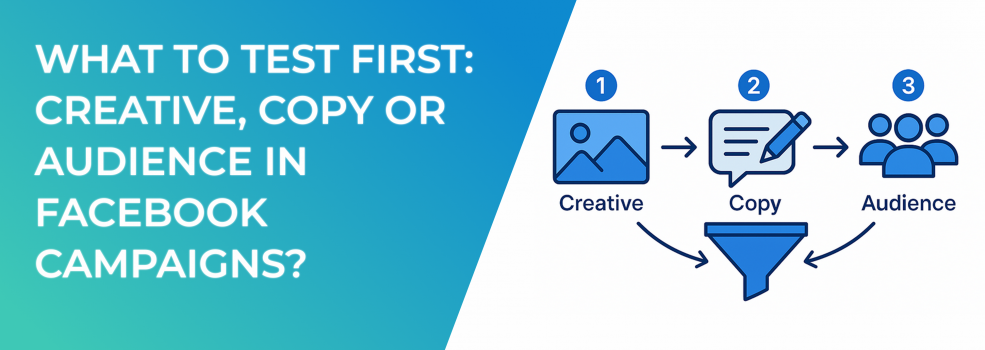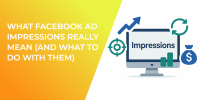Testing is the heartbeat of effective Facebook ad optimization. Yet many advertisers still wonder which lever to pull first: the visual ad creative, the written copy, or the audience targeting. Starting with the right variable accelerates learning, contains spend, and keeps campaigns out of the dreaded learning limited Facebook ads status. Below is a practical framework grounded in Facebook advertising best practices and the most important Facebook ad metrics to help you choose the smartest testing sequence for your next campaign.
1. Begin With the Variable That Limits Scale the Most
Think of creative, copy, and audience as three valves on the same pipeline. The valve with the tightest restriction should be opened first.
When you open the correct valve early, you avoid wasting budget on experiments that cannot scale. For example, if your audience pool is too narrow, even the most compelling image will struggle to exit the learning phase. Conversely, broad audiences cannot compensate for uninspiring visuals that fail to stop the scroll.
Why creative usually comes first
Visuals are processed 60,000 times faster than text, and they supply the first impression users use to judge relevance. If your images or videos fail to spark curiosity, even perfect copy cannot rescue performance. Weak creative inflates average CPC for Facebook ads and slows data collection, making later tests less reliable.
2. Testing Your Ad Creative
-
Hypothesis-driven variations. Change one dominant element at a time, such as switching from product-in-use footage to a lifestyle scene.
-
Use high-signal metrics. Early success appears in rising CTR and dropping CPC, while deeper wins emerge in Facebook advertising analytics such as cost per add-to-cart and cost per initiate checkout.
-
Protect delivery. Rotate three to five creatives per ad set to ensure poor performers do not throttle the entire budget and to keep the algorithm out of learning limited Facebook ads status.
Aim for a CTR of at least 1 to 2 percent, regarded by many sources as a good CTR in Facebook ads. Surpass that benchmark, then lock the winning visual and move on to copy testing.
3. Optimizing Your Ad Copy
Copy is where you clarify and amplify the promise made by the creative. A polished message can turn curiosity into action.
-
Value-prop order. Test leading with a primary benefit versus highlighting a pain point first.
-
Length. Compare punchy one-liners against story-driven paragraphs with social proof.
-
Call-to-action. Experiment with "Shop now" versus "See it in action" or "Get your free sample."
Monitor shifts in Facebook ads metrics such as link CTR, cost per landing page view, and Facebook ads conversion rate. A 10 to 15 percent lift in CTR without harming downstream sales signals a copy win worth scaling.
4. Exploring and Expanding Your Audience
Stable creative and copy make audience performance easier to judge. Begin broad to gather data quickly, then refine.
-
Interest stacks aligned to clearly defined personas help Facebook identify high-intent pockets of users.
-
Lookalikes built on your highest-LTV customers often drive lower CPMs and stronger conversion rates.
-
Predictive audiences generated from server-side, first-party data can unlock incremental scale when performance plateaus.
Begin broad, then refine audiences once creative and copy are proven.
Watch frequency and CPM closely. A rising CPM paired with flat CTR often means your ads are overserving a limited pool, so it may be time to refresh creative or open new segments.
5. Putting It All Together: A Lean Testing Roadmap
-
Creative test. Seek a 25 percent lift in CTR or a 20 percent drop in CPC before progressing.
-
Copy test. Target an incremental 10 to 15 percent CTR lift while maintaining or improving conversion rate.
-
Audience test. Pursue lower CPMs and higher reach efficiency, using Facebook ads cost per 1000 impressions to gauge progress.
Iterate this cycle every quarter or whenever key Facebook ad metrics decline. Document each learning in a shared repository so wins from one ad set inform the next campaign.
6. Pro Tips to Accelerate Learning
-
Use Advantage+ placements early to collect engagement data on multiple surfaces quickly.
Give each test at least two days so the algorithm can exit the learning phase. -
Turn on campaign budget optimization only after clear winners emerge in each phase to prevent budget dilution.
-
Lean on Facebook ads tips surfaced by Meta’s Aggregated Event Measurement, but always validate suggestions with controlled split tests.
-
Maintain at least a two-day learning window before making decisions. Cutting tests too soon traps campaigns in learning limited Facebook ads status and inflates costs.
Final Thoughts
There is no universal rule, yet most advertisers profit by testing ad creative first, then honing copy, and finally expanding or refining audiences. This sequence tackles the largest bottleneck, safeguards budget, and compounds wins. Each experiment becomes a step-change in performance rather than an expensive guess.
Leverage LeadEnforce’s granular targeting features to set up clean tests, surface actionable insights, and push winning combinations live with a single click.

